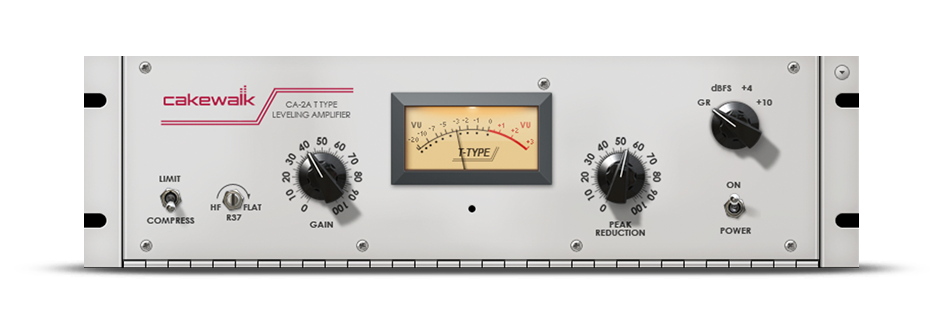Modeled to a T
The classic unit used for modeling is a soft-knee compressor featuring program dependent release times and a flat frequency response of 30Hz to 15kHz (see R37 control for frequency response adjustment). The attack time is fixed at 10 milliseconds while the release time is roughly 60 milliseconds for 50% release, and 0.5 to 5 seconds for full release, depending on the previous program material. This two-stage release results in extremely smooth and transparent compression characteristics.
The CA-2A T-Type Leveling Amplifier carefully models the tubes and the T4 electro-optical device in the original hardware units. The T4 circuit consists of an electroluminescent panel, partnered with an optical photocell, that together determine both the attack and release times. This results in complete program dependence and very little distortion. To realize the characteristic sound of the original hardware, the tubes are also modeled. The tube modeling supplies the warm, analog characteristics of the original unit. Total Harmonic Distortion (THD) comes from the four tubes in the original hardware, which slightly change the signal shape adding even and odd harmonics based on the frequency of the program material. The THD has a slight effect on the output gain; less than 0.35% to 0.75% at +10 dB to +16 dB of the program material.
The modeling of both the tubes and the T4 circuit is what gives the CA-2A T-Type Leveling Amplifier its unique compression characteristics. The curves are “wobbly” and only reduce gain to a certain point before “giving in” and letting the output level increase again. In addition to the program dependent release times, it also employs frequency dependent gain reduction, rather than having a fixed compression ratio across all frequencies.
The R37 Screw
The original hardware used for modeling was designed for leveling in radio and TV broadcast applications. Due to an increase in high frequency content in FM broadcasting the unit featured a back-panel, screw adjusted potentiometer with the rather mysterious name of “R37”. Basically it adjusts the unit’s gain reduction frequency response (High Frequency Pre-emphasis trim). On the original hardware unit, the R37 control adds gain reduction at frequencies above 1kHz, based on the program material. Use this control to reduce or prevent over-modulation on tracks caused by pre-emphasis (high-frequency sensitivity). When set to the FLAT position, gain reduction is applied equally on all frequencies. When the control is moved toward the HF position, gain reduction is increased on the high frequencies. While the FLAT setting finds most usage, adjusting the R37 control is often useful for de-essing (cut down sibilance by compressing high frequencies) or changing the tonality of vocals. Experiment to achieve a good balance between low and high frequency limiting.
The "Photocell Memory" Option
The CA-2A T-Type Leveling Amplifier emulates a classic hardware optical compressor. An optical compressor is different from an FET style compressor, in that it uses a luminescent panel and photocell to determine the amount of compression, attack and release times. These controls are not fixed, and are dependent on the reaction of the photocell, determined by the audio source. The photocell has unique properties that make optical compressors the prime choice for vocals and other material with smoother transients. But the hardware is not necessarily perfect. Longer, multi-stage release times result from high levels of gain-reduction. This will cause the photocell to "remember" its "on" or “lit” state, for a longer period of time. Attack-times become snappier as the input becomes more active, and relaxed (slower) during periods of less activity. After long periods of silence, the compressor can become very sluggish in its ability to reduce the gain of sudden transients. Under these conditions, the onset of a new transient can result in a “pop” at the output as the compressor is “waking up”. Since this behavior might not be desirable, we’ve included the “Fast Reset” mode to allow a faster wake-up time, and to avoid the "pop". The “Classic” mode sticks to the true emulation and responds like the original hardware.
Note: The original hardware unit is mono, and can be linked with a second unit for stereo leveling. CA-2A T-Type Leveling Amplifier operates in both mono and stereo modes without a loss in stereo imaging.
